NCERT Solutions for Class 12 Maths Chapter 11 - Three-Dimensional Geometry Miscellaneous Exercise
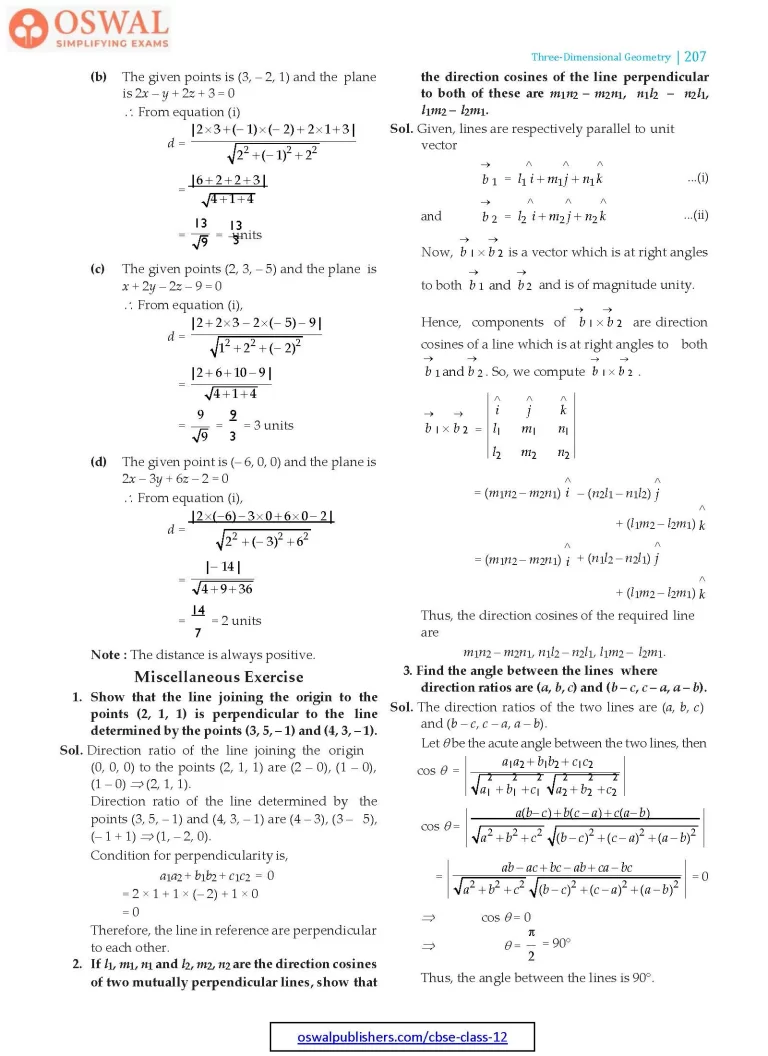
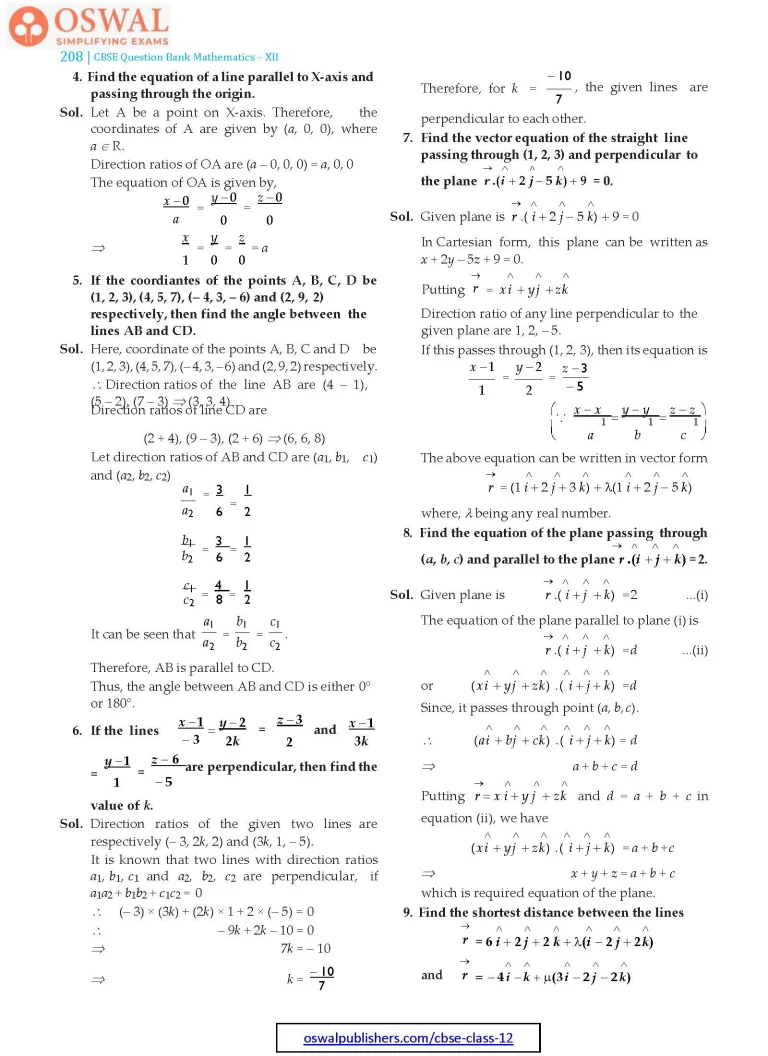
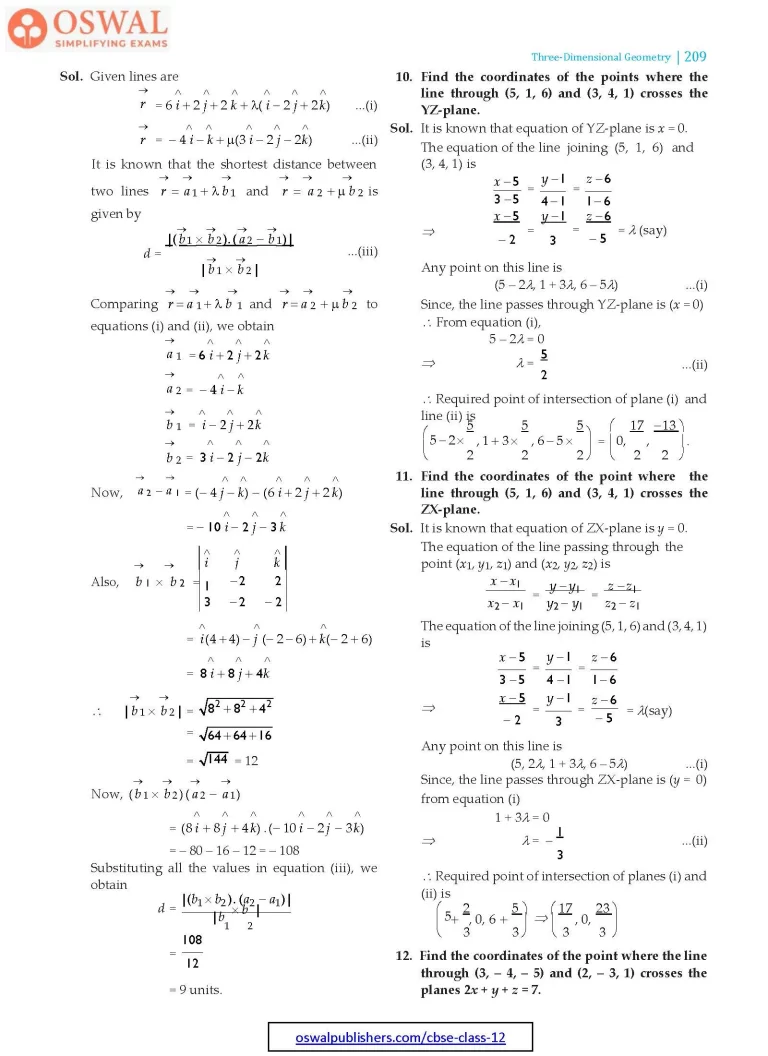
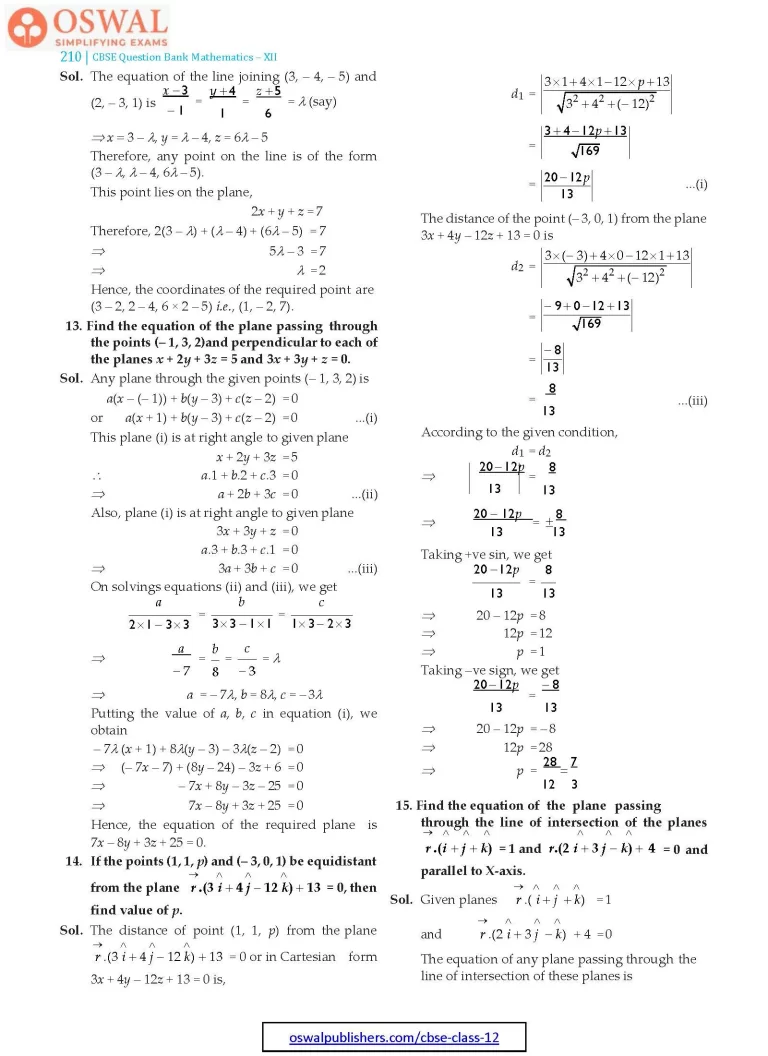
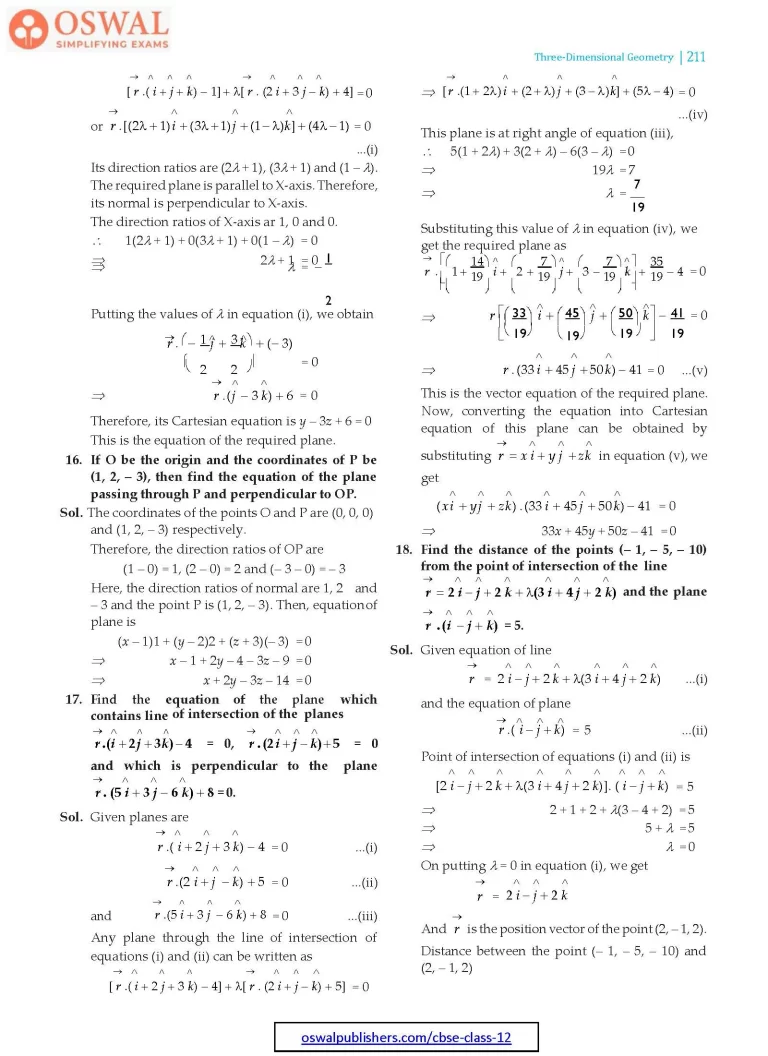
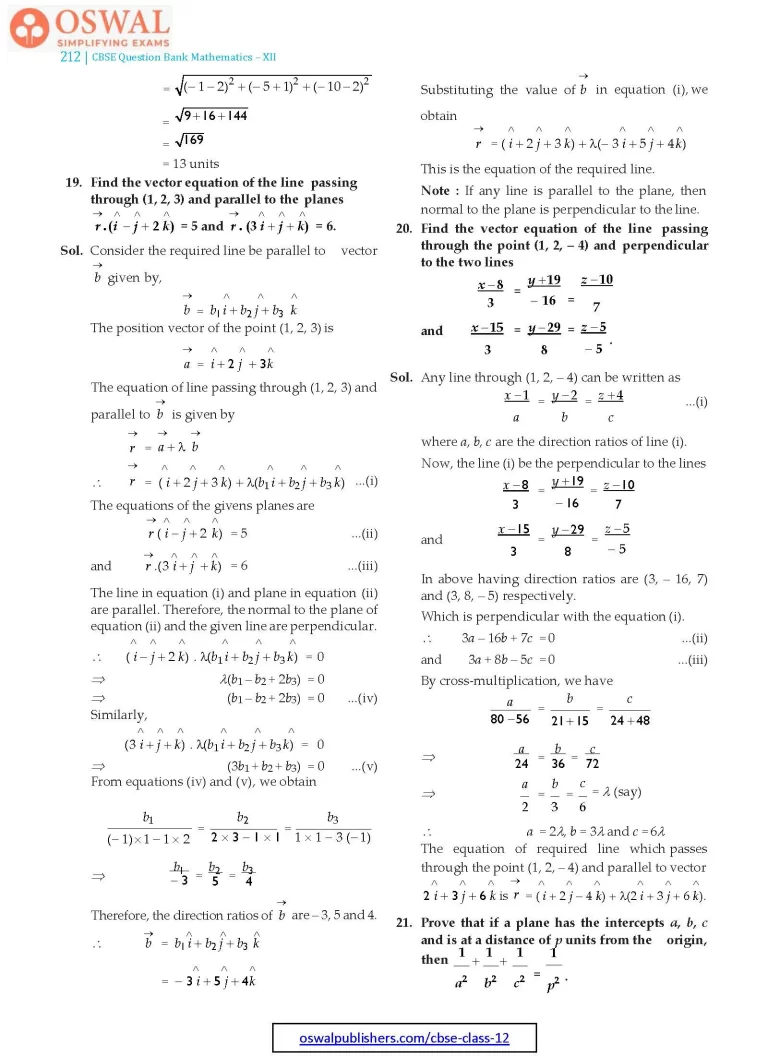
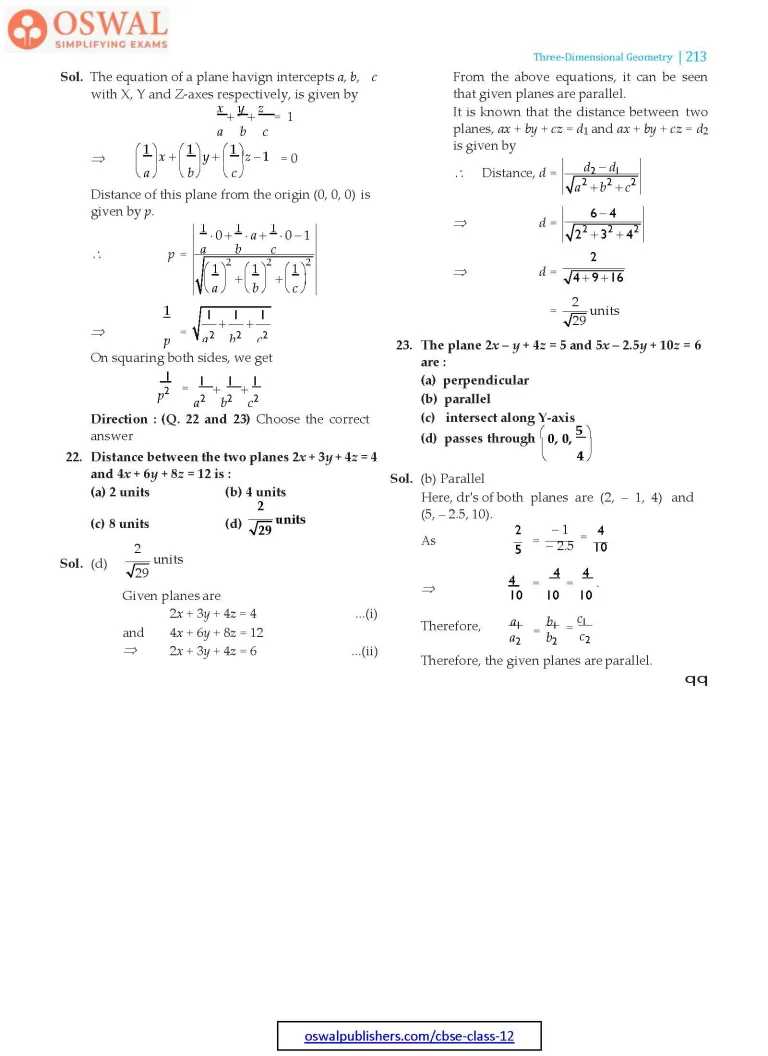
Access Exercises of Class 12 Maths Chapter 11 – Three Dimensional Geometry
Exercise 11.1 Solutions 5 Questions
Exercise 11.2 Solutions 17 Questions
Exercise 11.3 Solutions 14 Questions
Miscellaneous Exercise On Chapter 11 Solutions 23 Questions
Miscellaneous Exercise
1. Show that the line joining the origin to the points (2, 1, 1) is perpendicular to the line determined by the points (3, 5, – 1) and (4, 3, – 1).
Sol. Direction ratio of the line joining the origin
(0, 0, 0) to the points (2, 1, 1) are (2 – 0), (1 – 0), (1 – 0) ⇒ (2, 1, 1).
Direction ratio of the line determined by the points (3, 5, – 1) and (4, 3, – 1) are (4 – 3), (3 – 5), (– 1 + 1) ⇒ (1, – 2, 0).
Condition for perpendicularity is,
a1a2 + b1b2 + c1c2 = 0
= 2 × 1 + 1 × (– 2) + 1 × 0
= 0
Therefore, the line in reference are perpendicular to each other.
2. If l1, m1, n1 and l2, m2, n2 are the direction cosines of two mutually perpendicular lines, show that the direction cosines of the line perpendicular to both of these are m1n2 – m2n1, n1l2 – n2l1,
l1m2 – l2m1.
Sol. Given, lines are respectively parallel to unit vector
$$\vec{b}_1 = l_1\hat{i} + m_1\hat{j} + n_1\hat{k}\space\text{...(i)}\\\text{and}\space \vec{b}_2 = l_2\hat{i} + m_2\hat{j} + n_2\hat{k}\space\text{...(ii)}\\\text{Now,\space}\vec{b}_1×\vec{b}_2\space\text{is a vector which is }\\\text{at right angles to both}\space\vec{b}_1\space\text{and}\space\vec{b}_2$$
and is of magnitude unity.
Hence, components of
$$\vec{b}_1×\vec{b}_2\space\text{are direction cosines of}$$
a line which is at right angles to both
$$\vec{b}_1\space\text{and}\space\vec{b}_2.\space\text{So, we compute}\\\vec{b}_1×\vec{b}_2$$
$$\vec{b}_1×\vec{b}_2 = \begin{vmatrix}\hat{i} &\hat{j} &\hat{k}\\ l_1 &m_1 &n_1\\l_2 &m_2 &n_2\end{vmatrix}\\= (m_1n_2 - m_2n_1)\hat{i} - (n_2l_1 - n_1l_2)\hat{j}+\\(l_1m_2 - l_2m_1)\hat{k}\\ = (m_1n_2 - m_2n_1)\hat{i} + (n_1l_2 - n_2l_1)\hat{j}+\\(l_1m_2 - l_2m_1)\hat{k}$$
Thus, the direction cosines of the required line are
m1n2 – m2n1, n1l2 – n2l1, l1m2 – l2m1.
3. Find the angle between the lines where direction ratios are (a, b, c) and (b – c, c – a, a – b).
Sol. The direction ratios of the two lines are (a, b, c) and (b – c, c – a, a – b).
Let θ be the acute angle between the two lines, then
$$\text{cos}\space\theta = \bigg|\frac{a_1a_2 + b_1b_2 + c_1c_2}{\sqrt{a_1^{2} + b_1^{2}+c_1^{2}} \sqrt{a_2^{2} + b_2^{2} + c_2^{2}}}\bigg|$$
$$\text{cos}\space\theta =\\\bigg|\frac{a(b-c) + b(c-a) + c(a-b)}{\sqrt{a^{2} + b^{2}+ c^{2}}\sqrt{(b-c)^{2} + (c-a)^{2} + (a-b)^{2}}}\bigg|$$
$$=\\\bigg|\frac{ab-ac + bc-ab+ca-bc}{\sqrt{a^{2} + b^{2}+c^{2}}\sqrt{(b-c)^{2} + (c-a)^{2} + (a-b)^{2}}}\bigg|\\=0$$
$$\Rarr\space \text{cos}\space\theta = 0\\\Rarr\space \theta = \frac{\pi}{2}=90\degree$$
Thus, the angle between the lines is 90°.
4. Find the equation of a line parallel to X-axis and passing through the origin.
Sol. Let A be a point on X-axis. Therefore, the coordinates of A are given by (a, 0, 0), where a ∈ R.
Direction ratios of OA are (a – 0, 0, 0) = a, 0, 0
The equation of OA is given by,
$$\frac{x-0}{a}=\frac{y-0}{0}=\frac{z-0}{0}\\\Rarr\space\frac{x}{1} = \frac{y}{0} =\frac{z}{0}=a$$
5. If the coordiantes of the points A, B, C, D be (1, 2, 3), (4, 5, 7), (– 4, 3, – 6) and (2, 9, 2) respectively, then find the angle between the lines AB and CD.
Sol. Here, coordinate of the points A, B, C and D be (1, 2, 3), (4, 5, 7), (– 4, 3, – 6) and (2, 9, 2) respectively.
∴ Direction ratios of the line AB are (4 – 1),
(5 – 2), (7 – 3) ⇒ (3, 3, 4)
Direction ratios of line CD are
(2 + 4), (9 – 3), (2 + 6) ⇒ (6, 6, 8)
Let direction ratios of AB and CD are (a1, b1, c1) and (a2, b2, c2)
$$\frac{a_1}{a_2} =\frac{3}{6} =\frac{1}{2}\\\frac{b_1}{b_2} = \frac{3}{6} =\frac{1}{2}\\=\frac{c_1}{c_2} = \frac{4}{8} =\frac{1}{2}\\\text{It can be seen that}\\\frac{a_1}{a_2} = \frac{b_1}{b_2} = \frac{c_1}{c_2}.$$
Therefore, AB is parallel to CD.
Thus, the angle between AB and CD is either 0° or 180°.
6. If the lines
$$\frac{\textbf{x-1}}{\textbf{\normalsize-3}} \textbf{=} \frac{\textbf{y-2}}{\textbf{2k}} \textbf{=} \frac{\textbf{z-3}}{\textbf{2}}\\\textbf{and}\space \frac{\textbf{x-1}}{\textbf{3k}} = \frac{\textbf{y-1}}{\textbf{1}} =\frac{\textbf{z-6}}{\textbf{\normalsize-5}}$$
are perpendicular, then find the value of k.
Sol. Direction ratios of the given two lines are respectively (– 3, 2k, 2) and (3k, 1, – 5).
It is known that two lines with direction ratios a1, b1, c1 and a2, b2, c2 are perpendicular, if a1a2 + b1b2 + c1c2 = 0
∴ (– 3) × (3k) + (2k) × 1 + 2 × (– 5) = 0
∴ – 9k + 2k – 10 = 0
⇒ 7k = – 10
$$\Rarr\space k = \frac{-10}{7}\\\text{Therefore, for k =}\space\frac{-10}{7},$$
the given lines are perpendicular to each other.
7. Find the vector equation of the straight line passing through (1, 2, 3) and perpendicular to the plane
$$\vec{\textbf{r}}\textbf{.}\textbf{(}\hat{\textbf{i}} \textbf{+ 2}\hat{\textbf{j}}\textbf{-5}\hat{\textbf{k}}\textbf{) + 9 = 0.}\\\textbf{Sol.\space}\text{Given plane is}\\\vec{r}.(\hat{i} + 2\hat{j} -5\hat{k}) + 9 = 0$$
In Cartesian form, this plane can be written as x + 2y – 5z + 9 = 0.
$$\text{Putting}\space \vec{r} = x\hat{i} + y\hat{j}+z\hat{k}$$
Direction ratio of any line perpendicular to the given plane are 1, 2, – 5.
If this passes through (1, 2, 3), then its equation is
$$\frac{x-1}{1} = \frac{y-2}{2} = \frac{z-3}{-5}\\\bigg(\because\space \frac{x-x_1}{a} = \frac{y-y_1}{b} = \frac{z-z_1}{c}\bigg)$$
The above equation can be written in vector form
$$\vec{r} = (1\hat{i} + 2\hat{j} + 3\hat{k}) + \\\lambda(1\hat{i} + 2\hat{j} - 5\hat{k})\\\text{where, \space}\lambda \space\text{being any real number.}$$
8. Find the equation of the plane passing through (a, b, c) and parallel to the plane'
$$\vec{\textbf{r}}\textbf{.(}\hat{\textbf{i}} \textbf{+} \hat{\textbf{j}} \textbf{+}\hat{\textbf{k}}\textbf{) = 2.}\\\textbf{Sol.\space}\text{Given plane is}\space\\\vec{r}.(\hat{i}+ \hat{j} +\hat{k})=2\space\text{...(i)}$$
The equation of the plane parallel to plane (i) is
$$\vec{r}.(\hat{i} + \hat{j} + \hat{k}) = d\space\text{...(ii)}\\\text{or}\space (x\hat{i} + y\hat{j} + z\hat{k}).(\hat{i} +\hat{j} +\hat{k}) = d$$
Since, it passes through point (a, b, c).
$$\therefore\space (a\hat{i} + b\hat{j} + c\hat{k}).(\hat{i} + \hat{j} +\hat{k})=d\\\Rarr\space a+b+ c=d\\\text{Putting}\space\vec{r} = x\hat{i} + y\hat{j}+ z\hat{k}\space$$
and d = a + b + c in equation (ii), we have
$$(x\hat{i} + y\hat{j}+ z\hat{k}).(\hat{i} +\hat{j} +\hat{k})\\= a + b + c\\\Rarr\space x+y+z = a +b+c$$
which is required equation of the plane.
9. Find the shortest distance between the lines
$$\vec{\textbf{r}\space} \textbf{= 6}\hat{\textbf{i}}\textbf{+ 2}\hat{\textbf{j}}\textbf{+ 2}\hat{\textbf{k}} \textbf{+} \lambda(\hat{\textbf{i}}\space\textbf{- 2}\hat{\textbf{j}} \textbf{+ 2}\hat{\textbf{k}}\textbf{)}\\\textbf{and}\space \vec{\textbf{r}} = \normalsize{-}\textbf{4}\hat{\textbf{i}}-\hat{\textbf{k}} +\mu\textbf{(3}\hat{\textbf{i}}\textbf{- 2}\hat{\textbf{j}}\textbf{-2}\hat{\textbf{k}}\textbf{)}$$
Sol. Given lines are
$$\vec{r} = 6\hat{i} + 2\hat{j} +2\hat{k} + \lambda(\hat{i}-2\hat{j}+2\hat{k})\space\\\text{...(i)}\\\vec{r} =-4\hat{i} -\hat{k} + \mu(3\hat{i}-2\hat{j}-2\hat{k})\\\text{...(ii)} $$
It is known that the shortest distance between two lines
$$\vec{r} = \vec{a}_1 + \lambda\vec{b}_1\space\text{and}\space\vec{r} =\vec{a}_2 + \mu\vec{b}_2$$
is given by
$$d = \frac{|(\vec{b_1}×\vec{b_2}).(\vec{a_2}-\vec{a_1})|}{|\vec{b_1}×\vec{b_2}|}\space\\\text{...(iii)}$$
$$\text{Comparing}\space\vec{r} = \vec{a}_1 + \lambda\vec{b}_1\space\text{and}\space\\\vec{r} = \vec{a}_2 + \mu\vec{b}_2\space\\\text{to equations (i) and (ii), we obtain}\\\vec{a}_1 = 6\hat{i} + 2\hat{j}+2\hat{k}\\\vec{a}_2 =- 4\hat{i} - \hat{k}\\\vec{b}_1 = \hat{i} - 2\hat{j} + 2\hat{k}\\\vec{b}_2 = 3\hat{i}-2\hat{j}-2\hat{k}\\\text{Now,\space}\vec{a}_2 -\vec{a}_1 = (-4\hat{j} - \hat{k})-\\(6\hat{i} +2\hat{j}+ 2\hat{k})\\=-10\hat{i}-2\hat{j}-3\hat{k}$$
$$\text{Also,\space}\vec{b}_1×\vec{b}_2 = \\\begin{vmatrix}\hat{i} &\hat{j} &\hat{k}\\ 1&-2 &2\\ 3 &-2 &-2\end{vmatrix}\\ = \hat{i}(4+4) -\hat{j}(-2-6) + \hat{k}(-2+6)\\ = 8\hat{i}+8\hat{j}+4\hat{k}\\\therefore\space|\vec{b}_1×\vec{b}_2| = \sqrt{8^{2}+8^{2}+4^{2}}\\=\sqrt{64 + 64+16}\\=\sqrt{144} = 12\\\text{Now},\space (\vec{b}_1×\vec{b}_2)(\vec{a}_2 -\vec{a}_1)\\=(8\hat{i} + 8\hat{j} +4\hat{k}).(-10\hat{i}-2\hat{j}-3\hat{k})$$
10. Find the coordinates of the points where the line through (5, 1, 6) and (3, 4, 1) crosses the YZ-plane.
Sol. It is known that equation of YZ-plane is x = 0.
The equation of the line joining (5, 1, 6) and (3, 4, 1) is
$$\frac{x-5}{3-5} =\frac{y-1}{4-1} =\frac{z-6}{1-6}\\\Rarr\space \frac{x-5}{-2} = \frac{y-1}{3} =\frac{z-6}{-5}\\=\lambda\space(\text{say})$$
Any point on this line is
(5 – 2λ, 1 + 3λ, 6 – 5λ) ...(i)
Since, the line passes through YZ-plane is (x = 0)
∴ From equation (i),
5 – 2λ = 0
$$\Rarr\space \lambda = \frac{5}{2}\space\text{...(ii)}$$
∴ Required point of intersection of plane (i) and line (ii) is
$$\bigg(5 - 2×\frac{5}{2},1 + 3×\frac{5}{2}, 6-5×\frac{5}{2}\bigg)\\=\bigg(0,\frac{17}{2},\frac{-13}{2}\bigg).$$
= – 80 – 16 – 12 = – 108
Substituting all the values in equation (iii), we obtain
$$d = \frac{|(b_1×b_2).(a_2-a_1)|}{|b_1×b_2|}\\=\frac{108}{12}$$
= 9 units.
11. Find the coordinates of the point where the line through (5, 1, 6) and (3, 4, 1) crosses the ZX-plane.
Sol. It is known that equation of ZX-plane is y = 0.
The equation of the line passing through the point (x1, y1, z1) and (x2, y2, z2) is
$$\frac{x-x_1}{x_2-x_1} = \frac{y-y_1}{y_2-y_1} = \frac{z-z_1}{z_2-z_1}$$
The equation of the line joining (5, 1, 6) and (3, 4, 1) is
$$\frac{x-5}{3-5} = \frac{y-1}{4-1} =\frac{z-6}{1-6}\\\Rarr\space \frac{x-5}{-2} = \frac{y-1}{3} = \frac{z-6}{-5} =\lambda(\text{say}) $$
Any point on this line is
(5, 2λ, 1 + 3λ, 6 – 5λ) ...(i)
Since, the line passes through ZX-plane is (y = 0) from equation (i)
1 + 3λ = 0
$$\Rarr\space \lambda = -\frac{1}{3}\space\text{...(ii)}$$
∴ Required point of intersection of planes (i) and (ii) is
$$\bigg(5 + \frac{2}{3}, 0, 6 + \frac{2}{3}\bigg)\Rarr\space \bigg(\frac{17}{3}, 0, \frac{23}{3}\bigg)$$
12. Find the coordinates of the point where the line through (3, – 4, – 5) and (2, – 3, 1) crosses the planes 2x + y + z = 7.
Sol. The equation of the line joining (3, – 4, – 5) and (2, – 3, 1) is
$$\frac{x-3}{-1} = \frac{y + 4}{1} = \frac{z+5}{6} = \lambda (\text{Say})$$
⇒ x = 3 – λ, y = λ – 4, z = 6λ – 5
Therefore, any point on the line is of the form
(3 – λ, λ – 4, 6λ – 5).
This point lies on the plane,
2x + y + z = 7
Therefore,
2(3 – l) + (l – 4) + (6l – 5) = 7
⇒ 5λ – 3 = 7
⇒ λ = 2
Hence, the coordinates of the required point are (3 – 2, 2 – 4, 6 × 2 – 5) i.e., (1, – 2, 7).
13. Find the equation of the plane passing through the points (– 1, 3, 2)and perpendicular to each of the planes x + 2y + 3z = 5 and 3x + 3y + z = 0.
Sol. Any plane through the given points (– 1, 3, 2) is
a(x – (– 1)) + b(y – 3) + c(z – 2) = 0
or
a(x + 1) + b(y – 3) + c(z – 2) = 0 ...(i)
This plane (i) is at right angle to given plane
x + 2y + 3z = 5
∴ a.1 + b.2 + c.3 = 0
⇒ a + 2b + 3c = 0 ...(ii)
Also, plane (i) is at right angle to given plane
3x + 3y + z = 0
a.3 + b.3 + c.1 = 0
⇒ 3a + 3b + c = 0 ...(iii)
On solvings equations (ii) and (iii), we get
$$\frac{a}{2×1-3×3} = \frac{b}{3×3-1×1} \\= \frac{c}{1×3-2×3}\\\Rarr\space\frac{a}{-7} = \frac{b}{8} = \frac{c}{-3} =\lambda $$
⇒ a = – 7λ, b = 8λ, c = – 3λ
Putting the value of a, b, c in equation (i), we obtain
– 7λ (x + 1) + 8λ(y – 3) – 3λ(z – 2) = 0
⇒ (– 7x – 7) + (8y – 24) – 3z + 6 = 0
⇒ – 7x + 8y – 3z – 25 = 0
⇒ 7x – 8y + 3z + 25 = 0
Hence, the equation of the required plane is 7x – 8y + 3z + 25 = 0.
14. If the points (1, 1, p) and (– 3, 0, 1) be equidistant from the plane
$$\vec{\textbf{r}}\textbf{.}\textbf{(3}\hat{\textbf{i}} \textbf{+ 4}\hat{\textbf{j}} \textbf{- 12}\hat{\textbf{k}}\textbf{) + 13 =0},$$
$$\textbf{then find value of p.}$$
Sol. The distance of point (1, 1, p) from the plane
$$\vec{r}.(3\hat{i} + 4\hat{j} - 12\hat{k}) + 13 = 0\space\\\text{or in Cartesian form}\\\text{3x + 4y – 12z + 13 = 0 is,}$$
$$d_1 = \bigg|\frac{3×1 + 4×1 - 12×p+13}{\sqrt{3^{2} + 4^{2} + (-12)^{2}}}\bigg|\\=\bigg|\frac{3 + 4 - 12p + 13}{\sqrt{169}}\bigg|\\=\bigg|\frac{20-12p}{13}\bigg|\space\text{...(i)}$$
The distance of the point (– 3, 0, 1) from the plane 3x + 4y – 12z + 13 = 0 is
$$d_2 = \bigg|\frac{3×(-3) + 4×0 - 12×1+13}{\sqrt{3^{2}+4^{2} + (-12)^{2}}}\bigg|\\ = \bigg|\frac{-9+0-12+13}{\sqrt{169}}\bigg|\\=\bigg|\frac{-8}{13}\bigg|\\=\frac{8}{13}\space\text{... (iii)}$$
According to the given condition,
d1 = d2
$$\Rarr\space\bigg|\frac{20-12p}{13}\bigg| = \frac{8}{13}\\\Rarr\space \frac{20-12p}{13} =\pm\frac{8}{13}$$
Taking +ve sin, we get
$$\frac{20-12p}{13} = \frac{8}{13}$$
⇒ 20 – 12p = 8
⇒ 12p = 12
⇒ p = 1
Taking –ve sign, we get
$$\frac{20-12p}{13} = \frac{-8}{13}\\\Rarr\space 20-12p = -8\\\Rarr\space 12p = 28\\\Rarr\space p =\frac{28}{12} = \frac{7}{3}$$
15. Find the equation of the plane passing through the line of intersection of the planes
$$\vec{\textbf{r}}\textbf{.(}\hat{\textbf{i}} \textbf{+} \hat{\textbf{j}}\textbf{ +} \hat{\textbf{k}}\textbf{) = 1}\space\textbf{and}\\\space \textbf{r.(2}\hat{\textbf{i}} \textbf{+ 3}\hat{\textbf{j}}\textbf{-}\hat{\textbf{k}})\textbf{+4 =0}\\\textbf{and parallel to X-axis.}$$
Sol. Given planes
$$\vec{r}.(\hat{i} + \hat{j} + \hat{k})= 1\\\text{and}\space \vec{r}.(2\hat{i} + 3\hat{j} - \hat{k}) + 4 = 0$$
The equation of any plane passing through the line of intersection of these planes is
$$\lbrack\vec{r}.(\hat{i} + \hat{j} +\hat{k})-1\rbrack +\\\lambda\lbrack\vec{r}.(2\hat{i} + 3\hat{j} -\hat{k} +4)\rbrack = 0\\\text{or}\space \vec{r}.\lbrack(2\lambda +1)\hat{i} + (3\lambda + 1)\hat{j} +\\ (1 - \lambda)\hat{k}\rbrack + (4 - \lambda -1) = 0\\\text{...(i)}$$
Its direction ratios are (2λ + 1), (3λ + 1) and (1 – l).
The required plane is parallel to X-axis. Therefore, its normal is perpendicular to X-axis.
The direction ratios of X-axis ar 1, 0 and 0.
∴ 1(2λ + 1) + 0(3λ + 1) + 0(1 – l) = 0
⇒ 2λ + 1 = 0
$$\Rarr\space \lambda = -\frac{1}{2}$$
Putting the values of λ in equation (i), we obtain
$$\vec{r}.\bigg(-\frac{1}{2}\hat{j} + \frac{3}{2}\hat{k}\bigg) + (\normalsize-3)= 0\\\Rarr\space \vec{r}.(\hat{j} - 3\hat{k}) + 6 = 0$$
Therefore, its Cartesian equation is y – 3z + 6 = 0
This is the equation of the required plane.
16. If O be the origin and the coordinates of P be (1, 2, – 3), then find the equation of the plane passing through P and perpendicular to OP.
Sol. The coordinates of the points O and P are (0, 0, 0) and (1, 2, – 3) respectively.
Therefore, the direction ratios of OP are
(1 – 0) = 1, (2 – 0) = 2 and (– 3 – 0) = – 3
Here, the direction ratios of normal are 1, 2 and – 3 and the point P is (1, 2, – 3). Then, equation of plane is
(x – 1)1 + (y – 2)2 + (z + 3)(– 3) = 0
⇒ x – 1 + 2y – 4 – 3z – 9 = 0
⇒ x + 2y – 3z – 14 = 0
17. Find the equation of the plane which contains line of intersection of the planes
$$\vec{\textbf{r}}\textbf{.(}\hat{\textbf{i}} \textbf{+ 2}\hat{\textbf{j}} \textbf{+ 3}\hat{\textbf{k}}) \textbf{- 4 = 0,}\\\space \vec{\textbf{r}}.(\textbf{2}\hat{\textbf{i}} \textbf{+}\hat{\textbf{j}} - \hat{\textbf{k}}\textbf{)}\textbf{+ 5} \space\textbf{= 0}$$
and which is perpendicular to the plane
$$\vec{\textbf{r}}\textbf{.(}\textbf{5}\hat{\textbf{i}} \textbf{+ 3}\hat{\textbf{j}} \textbf{- 6}\hat{\textbf{k}}\textbf{)} \textbf{+ 8 = 0} $$
Sol. Given planes are
$$\vec{r}.(\hat{i} + 2\hat{j} +3\hat{k})-4 = 0\space\\\text{...(i)}\\\vec{r}.(2\hat{i} +\hat{j}-\hat{k}) + 5 =0\\\text{...(ii)}\\\text{and}\space \vec{r}.(5\hat{i} + 3\hat{j} -6\hat{k}) + 8 =0\\\text{...(iii)}$$
Any plane through the line of intersection of equations (i) and (ii) can be written as
$$\lbrack\vec{r}.(\hat{i} + 2\hat{j} + 3\hat{k}) - 4\rbrack +\\ \lambda\lbrack\vec{r}.(2\hat{i} + \hat{j} -\hat{k})+5\rbrack = 0\\\Rarr\space\lbrack\vec{r}.(1 + 2\lambda) +\hat{i} + (2 + \lambda)\hat{j}+\\(3-\lambda)\hat{k}\rbrack +(5\lambda - 4)=0\\\text{...(iv)}$$
This plane is at right angle of equation (iii),
∴ 5(1 + 2λ) + 3(2 + λ) – 6(3 – λ) = 0
⇒ 19λ = 7
$$\Rarr\space\lambda = \frac{7}{19}$$
Substituting this value of l in equation (iv), we get the required plane as
$$\vec{r}.\begin{bmatrix}\bigg(1 + \frac{14}{19}\bigg)\hat{i} + \bigg(2 + \frac{7}{19}\bigg)\hat{j} +\\ \bigg(3 -\frac{7}{19}\bigg)\hat{k}\end{bmatrix} +\\\frac{35}{19}-4 = 0\\\Rarr\space r\begin{bmatrix}\bigg(\frac{33}{19}\bigg)\hat{i} + \bigg(\frac{45}{19}\bigg)\hat{j} + \bigg(\frac{50}{19}\bigg)\hat{k}\end{bmatrix}\\-\frac{41}{19} = 0\\\Rarr\space r.(33\hat{i} + 45\hat{j} + 50\hat{k})-41 = 0\\\text{...(v)}$$
This is the vector equation of the required plane.
Now, converting the equation into Cartesian equation of this plane can be obtained by substituting
$$\vec{r} = x\hat{i} + y\hat{j} + z\hat{k}\space\\\text{in equation (v), we get}$$
$$(x\hat{i} + y\hat{j} + z\hat{k}).(33\hat{i} + \\45\hat{j} + 50\hat{k})- 41 =0\\\Rarr\space 33x + 45y + 50z - 41 = 0$$
18. Find the distance of the points (– 1, – 5, – 10) from the point of intersection of the line
$$\vec{\textbf{r}} \textbf{= 2}\hat{\textbf{i}} \textbf{-}\hat{\textbf{j}} \textbf{+ 2}\hat{\textbf{k}} \textbf{+} \lambda\textbf{(3}\hat{\textbf{i}} \textbf{+ 4}\hat{\textbf{j}} \textbf{+ 2}\hat{\textbf{k}})\\\textbf{and the plane}\space\vec{\textbf{r}}.(\hat{\textbf{i}} - \hat{\textbf{j}} + \hat{\textbf{k}})\textbf{= 5 .}$$
Sol. Given equation of line
$$\vec{r} = 2\hat{i} - \hat{j} + 2\hat{k} +\\ \lambda(3\hat{i} + 4\hat{j}+2\hat{k})\space\text{...(i)} $$
and the equation of plane
$$\vec{r}.(\hat{i} - \hat{j} + \hat{k})=5\space\text{...(ii)}$$
Point of intersection of equations (i) and (ii) is
$$\lbrack2\hat{i} -\hat{j} +2\hat{k} + \lambda(3\hat{i} + 4\hat{j}+ 2\hat{k})\rbrack\\.(\hat{i} -\hat{j}+ \hat{k}) = 5\\\Rarr\space 2+1+2+\lambda(3-4+2) =5\\\Rarr\space 5 +\lambda = 5\\\Rarr\space \lambda = 0\\\text{On putting}\space\lambda = 0\space\\\text{in equation (i), we get}\\\vec{r} = 2\hat{i} -\hat{j} + 2\hat{k}\\\text{And}\space\vec{r}\space \text{is the position vector}\\\text{of the point (2, – 1, 2)}$$
$$ = \sqrt{(-1-2)^{2} + (-5+1)^{2} + (-10-2)^{2}}\\=\sqrt{9 +16 + 144}\\=\sqrt{169}$$
= 13 units
19. Find the vector equation of the line passing through (1, 2, 3) and parallel to the planes
$$\vec{\textbf{r}}\textbf{.(}\hat{\textbf{i}} -\hat{\textbf{j}} \textbf{+ 2}\hat{\textbf{k}}\textbf{)} \textbf{= 5}\space\textbf{and}\\\vec{\textbf{r}}\textbf{.(3}\hat{\textbf{i}}\textbf{+} \hat{\textbf{j}} + \hat{\textbf{k}}\textbf{)} \textbf{= 6}\textbf{.}$$
Sol. Consider the required line be parallel to vector
$$\vec{b}\space\text{given by,}\\\vec{b} = b_1\hat{i} + b_2\hat{j} +b_3\hat{k}$$
The position vector of the point (1, 2, 3) is
$$\vec{a} = \hat{i} + 2\hat{j} + 3\hat{k}$$
The equation of line passing through (1, 2, 3) and parallel to
$$\vec{b}\space \text{is given by}\\\vec{r} =\vec{a} + \lambda\vec{b}\\\therefore\space \vec{r} = (\hat{i} + 2\hat{j} + 3\hat{k}) + \\\lambda(b_1\hat{i} + b_2\hat{j} + b_3\hat{k})\\\text{...(i)}$$
The equations of the givens planes are
$$\vec{r}(\hat{i} - \hat{j} +2\hat{k})=5\space\text{...(ii)}\\\text{and}\space \vec{r}.(3\hat{i} + \hat{j} + \hat{k}) =6\space\text{...(iii)}$$
The line in equation (i) and plane in equation (ii) are parallel. Therefore, the normal to the plane of equation (ii) and the given line are perpendicular.
$$\therefore\space (\hat{i} -\hat{j} + 2\hat{k}).\\\lambda(b_1\hat{i} + b_2\hat{j} +b_3\hat{k}) = 0\\\Rarr\space\lambda(b_1-b_2+2b_3) = 0\\\Rarr\space (b_1 - b_2 +2b_3) =0\space\text{...(iv)}\\\text{Similarly,}\\(3\hat{i} + \hat{j} + \hat{k}) .\lambda(b_1\hat{i} + b_2\hat{j} + b_3\hat{k}) =0\\\Rarr\space (3b_1 +b_2 +b_3) =0\\\text{...(v)}$$
From equations (iv) and (v), we obtain
$$\frac{b_1}{(-1)×1×-1×2} = \frac{b_2}{2×3-1×1}\\=\frac{b_3}{1×1-3(-1)}\\\Rarr\space \frac{b_1}{-3} = \frac{b_2}{5} = \frac{b_3}{4}$$
Therefore, the direction ratios of
$$\vec{b}\space \text{are -3,5 and 4}\\\therefore\space \vec{b} = b_1\hat{i} + b_2\hat{j} + b_3\hat{k}\\ = -3\hat{i} + 5\hat{j} + 4\hat{k}\\\text{Substituting the value of}\space\vec{b}\\\text{in equation (i), we obtain}\\\vec{r} = (\hat{i} + 2\hat{j} + 3\hat{k}) + \lambda(-3\hat{i} + 5\hat{j} + 4\hat{k})$$
This is the equation of the required line.
Note : If any line is parallel to the plane, then normal to the plane is perpendicular to the line.
20. Find the vector equation of the line passing through the point (1, 2, – 4) and perpendicular to the two lines
$$\frac{\textbf{x-8}}{\textbf{3}} \textbf{=} \frac{\textbf{y + 19}}{\normalsize{-}\textbf{16}} \textbf{=}\frac{\textbf{z-10}}{\textbf{7}}\\\textbf{and}\space \frac{\textbf{x-15}}{\textbf{3}} \textbf{=}\frac{\textbf{y - 29}}{\textbf{8}} \textbf{=}\frac{\textbf{z-5}}{\textbf{-5}}. $$
Sol. Any line through (1, 2, – 4) can be written as
$$\frac{x-1}{a} = \frac{y-2}{b} = \frac{z+4}{c}\space\text{...(i)}$$
where a, b, c are the direction ratios of line (i).
Now, the line (i) be the perpendicular to the lines
$$\frac{x-8}{3} =\frac{y +19}{-16} =\frac{z-10}{7}\\\text{and}\space \frac{x - 15}{3} =\frac{y - 29}{8} =\frac{z-5}{-5}$$
In above having direction ratios are (3, – 16, 7) and (3, 8, – 5) respectively.
Which is perpendicular with the equation (i).
∴ 3a – 16b + 7c = 0 ...(ii)
and 3a + 8b – 5c = 0 ...(iii)
By cross-multiplication, we have
$$\frac{a}{80 -56}=\frac{b}{21 + 15} =\frac{c}{24 + 48}\\\Rarr\space \frac{a}{24} = \frac{b}{36} =\frac{c}{72}\\\Rarr\space\frac{a}{2} =\frac{b}{3}=\frac{c}{6} =\lambda (\text{say})\\\therefore a=2\lambda, b= 3\lambda\space\text{and}\space c = 6\lambda$$
The equation of required line which passes through the point (1, 2, – 4) and parallel to vector
$$2\hat{i} + 3\hat{j} +6\hat{k}\space\text{is}\\\space\vec{r} =(\hat{i} + 2\hat{j} -4\hat{k})+ \lambda(2\hat{i} +3\hat{j} +6\hat{k}).$$
21. Prove that if a plane has the intercepts a, b, c and is at a distance of p units from the origin, then
$$\frac{\textbf{1}}{\textbf{a}^{\textbf{2}}} \textbf{+} \frac{\textbf{1}}{\textbf{b}^{\textbf{2}}} \textbf{+} \frac{\textbf{1}}{\textbf{c}^{\textbf{2}}} \textbf{=}\frac{\textbf{1}}{\textbf{p}^{\textbf{2}}}\textbf{.} $$
Sol. The equation of a plane havign intercepts a, b, c with X, Y and Z-axes respectively, is given by
$$\frac{x}{a} + \frac{y}{b} + \frac{z}{c}=1\\\Rarr\space\bigg(\frac{1}{a}\bigg)x + \bigg(\frac{1}{b}\bigg)y + \bigg(\frac{1}{c}\bigg)z-1 \\=0$$
Distance of this plane from the origin (0, 0, 0) is given by p.
$$\therefore\space\text{p =}\space\begin{vmatrix}\frac{\frac{1}{a}.0 + \frac{1}{b}.a + \frac{1}{c}.0-1}{\sqrt{\bigg(\frac{1}{a}\bigg)^{2} + \bigg(\frac{1}{b}\bigg)^{2} + \bigg(\frac{1}{c}\bigg)^{2}}}\end{vmatrix}\\\Rarr\space\frac{1}{\text{P}} =\sqrt{\frac{1}{a^{2}} + \frac{1}{b^{2}} + \frac{1}{c^{2}}}$$
On squaring both sides, we get
$$\frac{1}{p^{2}} =\frac{1}{a^{2}} +\frac{1}{b^{2}} + \frac{1}{c^{2}}$$
Direction : (Q. 22 and 23) Choose the correct answer
22. Distance between the two planes 2x + 3y + 4z = 4 and 4x + 6y + 8z = 12 is :
(a) 2 units
(b) 4 units
(c) 8 units
$$\textbf{(d)}\space\frac{\textbf{2}}{\sqrt{\textbf{29}}}\space\textbf{units}\\\textbf{Sol.\space}\text{(d)\space}\frac{2}{\sqrt{29}}\text{units}$$
Given planes are
2x + 3y + 4z = 4 ...(i)
and 4x + 6y + 8z = 12
⇒ 2x + 3y + 4z = 6 ...(ii)
From the above equations, it can be seen that given planes are parallel.
It is known that the distance between two planes, ax + by + cz = d1 and ax + by + cz = d2 is given by
$$\therefore\space\text{Distance, d = }\begin{vmatrix}\frac{d_2-d_1}{\sqrt{a^{2}} +b^{2}+ c^{2}}\end{vmatrix}\\\Rarr\space d = \bigg|\frac{6-4}{\sqrt{2^{2} +3^{2} + 4^{2}}}\bigg|\\\Rarr\space d = \frac{2}{\sqrt{4 + 9 +16}}\\ = \frac{2}{\sqrt{29}}\space\text{units}$$
23. The plane 2x – y + 4z = 5 and 5x – 2.5y + 10z = 6 are :
(a) perpendicular
(b) parallel
(c) intersect along Y-axis
$$\textbf{(d)\space passes through}\space\bigg(\textbf{0,0,}\frac{\textbf{5}}{\textbf{4}}\bigg)$$
Sol. (b) Parallel
Here, dr's of both planes are (2, – 1, 4) and (5, – 2.5, 10).
$$\text{As\space}\frac{2}{5} = \frac{-1}{-2.5} =\frac{4}{10}\\\Rarr\space\frac{4}{10} = \frac{4}{10} =\frac{4}{10}.\\\text{Therefore,\space}\\\frac{a_1}{a_2} =\frac{b_1}{b_2} =\frac{c_1}{c_2}$$
Therefore, the given planes are parallel.
Share page on
NCERT Solutions Class 12 Mathematics
- Chapter 1 Relations and Functions
- Chapter 2 Inverse Trigonometric Functions
- Chapter 3 Matrices
- Chapter 4 Determinants
- Chapter 5 Continuity and Differentiability
- Chapter 6 Application of Derivatives
- Chapter 7 Integrals
- Chapter 8 Applications of the Integrals
- Chapter 9 Differential Equations
- Chapter 10 Vectors
- Chapter 11 Three-Dimensional Geometry
- Chapter 12 Linear Programming
- Chapter 13 Probability
CBSE CLASS 12 NCERT SOLUTIONS
- NCERT Solutions Class 12 English Core
- NCERT Solutions Class 12 Physics
- NCERT Solutions Class 12 Chemistry
- NCERT Solutions Class 12 Biology
- NCERT Solutions Class 12 Business Studies
- NCERT Solutions Class 12 Mathematics
- NCERT Solutions Class 12 Accountancy
- NCERT Solutions Class 12 Economics
- NCERT Solutions Class 12 Geography
- NCERT Solutions Class 12 History
- NCERT Solutions Class 12 Political Science
CBSE CLASS 12 SYLLABUS
- CBSE Class 12 English core Syllabus
- CBSE Class 12 Mathematics Syllabus
- CBSE Class 12 Physics Syllabus
- CBSE Class 12 Chemistry Syllabus
- CBSE Class 12 Biology Syllabus
- CBSE Class 12 Accountancy Syllabus
- CBSE Class 12 Business Studies Syllabus
- CBSE Class 12 Economics Syllabus
- CBSE Class 12 History Syllabus
- CBSE Class 12 Geography Syllabus
- CBSE Class 12 Political science Syllabus
- CBSE Class 12 Sociology Syllabus
- CBSE Class 12 Psychology Syllabus
- CBSE Class 12 Physical education Syllabus
- CBSE Class 12 Applied mathematics Syllabus
- CBSE Class 12 History of Indian Arts Syllabus
CBSE CLASS 12 Notes
- CBSE Class 12 Physics Notes
- CBSE Class 12 Chemistry Notes
- CBSE Class 12 Biology Notes
- CBSE Class 12 Maths Notes
- CBSE Class 12 Accountancy Notes
- CBSE Class 12 Business Studies Notes
- CBSE Class 12 Economics Notes
- CBSE Class 12 History Notes
- CBSE Class 12 Geography Notes
- CBSE Class 12 Political Science Notes

